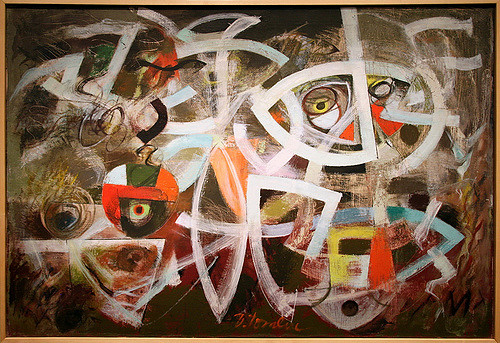
During the past four decades, a retrospective exhibition on abstract expressionist and resident of the Woodstock art colony Bradley Walker Tomlin has remained unseen, until now.
The Samuel Dorsky Museum of Art recently debuted four new fall exhibitions two weeks ago, including “Bradley Walker Tomlin: A Retrospective.” Former Dorsky curator of exhibitions and programs Daniel Belasco curated the exhibition. On Sunday, Sept. 11, the museum hosted a panel discussion to commemorate the exhibition’s opening. Panelists included: art historian and critic Svetlana Alpers, curator Belasco and professor of art history at Bard College, Tom Wolf.
According to a Dorsky gallery guide written by Belasco, the exhibit is arranged chronologically, spanning from Tomlin’s early achievements as an illustrator to ornamental still life paintings, “Cubist-Surrealist compositions,” and finally large-scale abstract expressionist pieces.
Belasco quotes the artist as saying, “One can believe in paintings, as one can believe in miracles for paintings, like miracles, possess an inner logic which is inescapable.”
Janis Benincasa, program manager at the Dorsky, said the museum always attempts to have panels coincide with each of their major exhibitions. Benincasa believes that these discussions bring the exhibitions to another level beyond the astounding visuals and texts through a group of experts.
“It’s just a way of giving a fuller visual of the artist and the art,” Benincasa said.
On Sunday, each panelist brought a different take on Tomlin. The afternoon began with an introduction from Neil C. Trager Gallery Director Sarah J. Pasti. Executive Director of the Woodstock Artists Association and Museum Janice La Motta moderated the conversation, which ranged from Tomlin’s personal life to his evolution as an artist.
Belasco spoke first and presented a slideshow to a small group of attendees ranging in age. He examined Tomlin’s journey through photographs of Tomlin and pivotal pieces. The audience learned that Tomlin, his wife and artist Frank Marsden London lived together. However, historical evidence suggests that his romantic partnership remained with London. Audience members discovered that his painting, “Tension by Moonlight,” which featured white streaky brush strokes on a black canvas, led him to his artistic niche.
After Belasco, Wolf took the floor and talked about Tomlin’s life in Woodstock where a hub of groundbreaking artists gathered. Tomlin started going there during the summer months of his 20s. Then Alpers passionately expressed her love of underappreciated Tomlin and the Dorsky’s exhibition.
“I am a painter person and I think Tomlin is just a great painter,” Alpers said.
Following Alpers, La Motta welcomed questions from the audience. The crowd pondered why Tomlin wasn’t as successful, to which the experts responded. During Tomlin’s day the crème de la crème of patron collected his work. However, he had no legacy, collectors or family to pass it onto over time. Tomlin also destroyed a lot of his art during his 30s, gained notoriety in his 40s and then died at age 54.
Belasco emphasized the importance of this event for students. Tomlin proves that someone can have multiple careers over the course of their lifetime and finally find their voice at age 40.
Third-year double major in art history and English Carter Kranick attended the event for class. As an employee of the Dorsky they found the program insightful.
“I really enjoyed seeing them speak,” they said. “I could listen to Svetlana all day. She is so passionate about it!”
